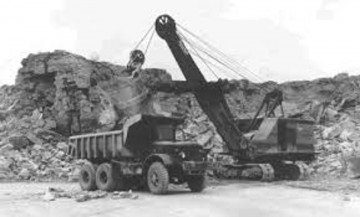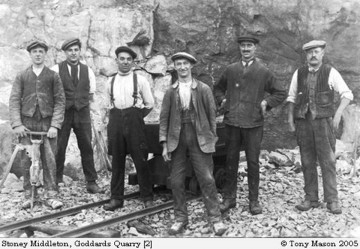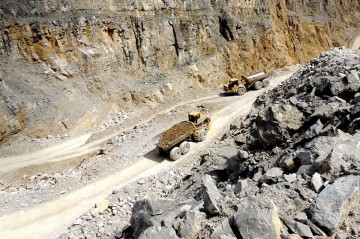Limestone Quarrying

Limestone has been quarried in Stoney Middleton dale for centuries, a principle industry and employer during the last century. Thousands of tons of rock have been removed to produce vital minerals and metals and to simply provide stone for construction.The village had many quarries along The Dale, spreading from Darlton quarry (opposite Lovers Leap Garage) to Furness Quarry (now known as Horseshoe quarry) half a mile past the turning for Eyam.
Geology of limestone
The Peak District of Derbyshire is at the southern end of the Pennine ‘backbone’ of hills which runs up through northern England. The Peak is made up of a limestone upland plateau known as the High Peak and the lower valleys known as the White Peak and home to Stoney Middleton. This carboniferous limestone was deposited over 300 million years ago, an accumulation of millions of tiny creatures collecting on the bed of what was a tropical sea.
History of the limestone quarrying
Limestone was first quarried in Derbyshire in Roman times, for building stone and to produce lime and lead. It continued through the ages until recent times. The stone was used for interiors in numerous important buildings including, Chatsworth House, Windsor Castle, Houses of Parliament, the Bank of England and many cathedrals.
Primitive quarrying methods

Early methods of quarrying were very primitive and dependent upon manpower to split and break up the rocks with little mechanisation beyond a horse and cart.
The Limestone Industry comes of age with the Industrial revolution
The use of gunpowder in blasting at the beginning of the 19th century established limestone quarrying and significantly increased production. The stone was used for burning to produce quicklime, a soil improver used by farmers and for the newer industries that developed with industrial revolution. Limestone was crushed and used for road surfaces and in the production of asphalt macadam. By the early 20th century large volumes of limestone were used as a flux in blast furnaces for smelting iron and in the large-scale manufacture of glass.
The development of ground calcium carbonates for modern uses
The latter part of the twentieth century has seen major changes to the extraction of limestone, and the manufacturing and finishing capabilities of the industry enabling a new generation of finely ground products to be produced. Uses of Ground calcium carbonates (often called GCC) range from animal and pet feeds, ceramic tile adhesives and concrete to plasters and textured finishes, carpet-backing, plastics and rubber. Applications that our forbears, even less than a century ago, would have struggled to have imagined.
Derbyshire the UK’s largest lime and limestone producer

Since the 17th century, the Peak District has been Britain’s largest lime and limestone producer. The rich deposits of carboniferous limestone have provided – and are still providing – vast quantities of raw materials for use in industry.
Limestone applications
Limestone (Calcium Carbonate) is very important in ways few would imagine and is evident in our everyday lives. Most common household products contain the material in one form or another, from toothpaste and pills to adhesives for construction, holding up the tiles on our walls. Tiles on the roof, carpets on the floor, glass in the windows and jars in the cupboard are all dependant on limestone.
Calcium carbonate is added to the land and into animal feeds and finds its way through the food chain to the bones in our bodies. It is an essential neutraliser, balancing acidity and improving drainage and aeration to increase crop yields.
Common uses for limestone.
Fine/Ultrafine Ground
- Adhesives & Sealants
- Antacids (digestion)
- Food & Drink
- Household Products
- Paper
- Paint & Inks
- Personal Care Products
- Pharmaceuticals
- Plasters/Textured Finishes
- Plastics
- Rubber
Coarse/Medium Ground
- Agricultural liming
- Animal & Pet Feeds
- Asphalt Filler
- Carpet-backing
- Ceramics
- Fertilisers
- Mining
- Precast Concrete
- PVC Floor Tiles
- Self-compacting Concrete (SCC)
- Shower Trays
- Waste & Water Treatment
Limestone Aggregates
- Construction Aggregates
- Concrete
- Drainage & Pitching
- Landscaping
- Pipe Bedding
- Road Construction
- Roof Chippings
Chemical Stone
- Cement Manufacture
- Chemical Production
- Flue Gas Desulphurisation
- Glass Manufacture
- Iron & Steel Production
- Sugar-Refining
Lime (burnt lime)
- Aerated Concrete Blocks
- Biosolids
- Calcium Silicate Bricks
- Chemical Manufacture
- Contaminated Land
- Effluent Treatment
- Flue Gas Desulphurisation
- Glass
- Iron & Steel Production
- Limewash
- Lime Mortars
- Motor Oil Additives
- Plastics
- Water Treatment
Read More factsheet4-quarrying
This is a great article.I grew up in Stoney Middleton in the 1970s & 80s & my first job was working at Dalton Quarry(then Wimpey Asphalt) in 1987/88.It was a busy place then employing many locals & Goddards quarry just down the road was still going but on a much smaller scale.My Dad & brother both worked at Glebe Mines (then Laporte Industries)which is the only one still operating today(2018).
I worked at Dalton Quarry 1964 to 1967 as lab assistant for Wimpey, with a break at Tibshelf during M1 construction using Dalton stone.Stayed at Lovers Leap cafe then B&B drinking at Grouse pub.
I started with Wimpey Asphalt at Leapers wood on the M6 contract in 1970 working in the Lab. I worked for about a month at Dalton Quarry about November 1975. I think the manager then was a man called Hunt. A friend and Colleague of mine Willy Walsh was based in Dalton, does anybody remember him and know where he is now.
I used to buy stone from Glebe mine from Francis Hall – I also worked for North Lonsdale who owned Goddards and Shinig Bank in Alport
Dave Westnage
Used to work there when it was wimpey building products, worked at the cast and hand finished brick/block plant.